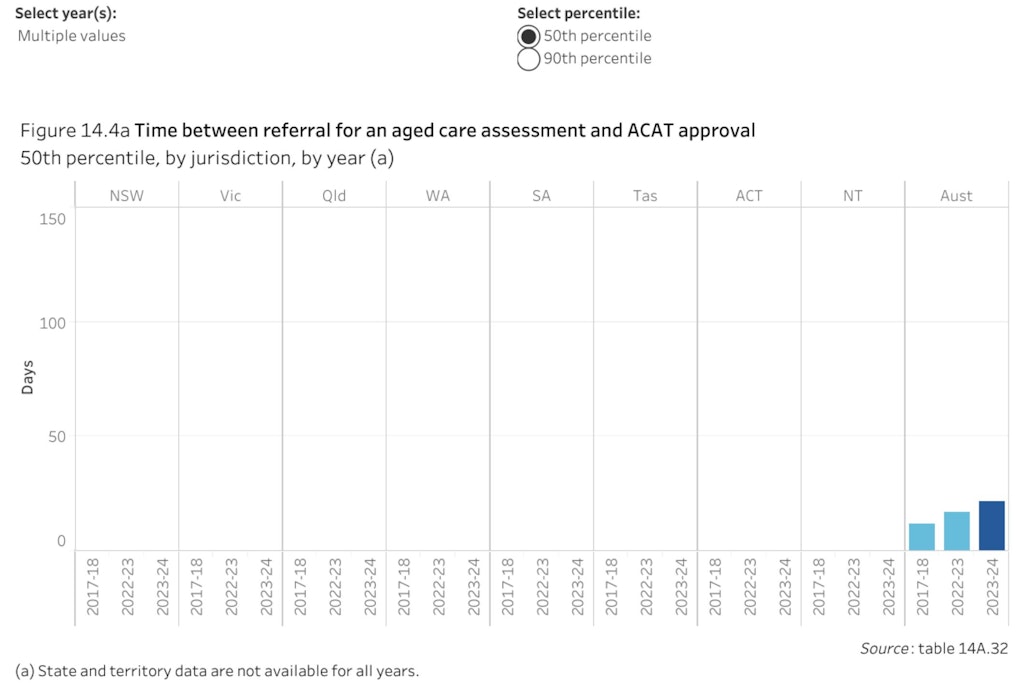Home care bucks the trend as aged care wait times increase
Published on 5 February 2025 (Last updated on 13 February 2025)

Aged care assessment wait times have more than doubled for some older Australians in the last eight years with recently released government data revealing mixed fortunes for people wanting to access home care services compared to entering residential care.
Key points
- The Report on Government Services has been released by the Productivity Commission, detailing spending and outcomes in sectors such as aged care
- In 2023-24, government recurrent expenditure on aged care services was $36.4 billion or $7,452 per older person
- Roughly 62% of expenditure went to residential and flexible care services with home care and home support services accounting for much of the remainder
- Unmet needs are growing in Australia with over 15% of people eligible for aged care services requiring more formal assistance than they currently receive
- Days waited between referral and ACAT approval is also growing with wait times doubling since 2017-18 for both the 50th and 90th percentile of those referred for an assessment
ACAT approval a growing hurdle

Aged care assessment times have nearly doubled for many older Australians. Data from the Productivity Commission reveals that 50% of older people referred for an aged care assessment waited up to 22 days to receive an ACAT approval in 2023-24.
This compares to 17 days in 2022-23 and 12 days in 2017-18.
The median wait time of 22 days means that half of older people have a shorter elapsed time, while half have a longer elapsed time.
Growth is most extreme for the 90th percentile of older people waiting for ACAT approval.
In 2017-18, 10% of people referred for an aged care assessment faced a longer-than-desired wait time of 67 days. This figure ballooned to 98 days by 2022-23 and now sits at a worrying 138 days or just over four months.
Home care bucks the trend

Depending on their package level, someone approved for a Home Care Package (HCP) could wait between three and 15 months for the assignment of an approved HCP.
While this figure is still incredibly high, nationally, the time between ACAT approval and the assignment of an HCP has decreased considerably since 2017-18. The median wait time then was 247 days for all priority groups compared to 78 days in 2023-24.
High priority groups have seen a slight rise after taking positive strides with the median wait time rising from seven days in 2022-23 to 11 last year.
Unfortunately, the time between ACAT approval and service commencement date sits at a median of 118 days. This highlights the risk potential for older people approved for a service that still have to face another delay before essential services actually begin.
Then there is the minority sitting at the extreme end of the scale: 10% of older people waited at least 216 days to be assigned an HCP and 260 days to receive a service.
Meaningful strides have been made for high priority groups in the same percentile. In 2017-18 the wait time for assignment was 158 and commencement 203 days. Now it is 13 and 76 days, respectively.
Residential care remains steady

Residential care trends have remained steady over the past eight years as wait times have increased slightly for the average person.
- Nationally, in 2023-24, permanent residents who entered care during the financial year and within one year of ACAT approval had an elapsed time of 68 days at the 50th percentile and 253 days at the 90th percentile
- In 2017-18, the 50th percentile had an elapsed time of 61 days and the 90th percentile 257
- Of all people admitted to residential care with known elapsed times in 2023-24, 67.2% were admitted within one year of ACAT approval
Meanwhile, in 2023-24, almost 42% of older people entered residential aged care within three months of their ACAT approval. The median elapsed time was 136 days, a decrease from a ten year high of 163 days in 2020-21.
Nationally, the median elapsed time between ACAT approval and entry into aged care services increased by 100%, between 2014-15 and 2023-24.
The most worrying trend here is the percentage of older people waiting nine months or more to enter residential aged care. This has doubled in the past decade, rising from 18.7% to 38.3% (a figure that has remained steady the past two years).

The Australian Government hopes to reduce the wait time for home care packages under Support at Home to three months by 2027. The single assessment system may streamline the process, and combined with the increased supply of home care services, this is a realistic timeframe.
Data released in the Report on Government Services next year will show if progress can occur that quickly, or not.